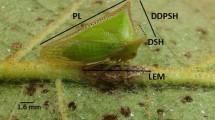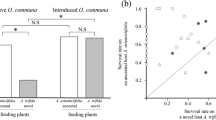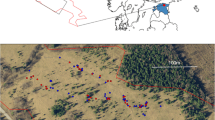Summary
In Papilio machaon host plant utilization is argued to be proximally guided by adult and larval preferences, both of which are genetically determined. To decide whether these preferences are controlled by one or two gene complexes, oviposition preferences and larval survival of a Scandinavian population were investigated with regard to all potential host plants in the region. The experiments revealed a substantial difference between the potential host plant ranges of the adults and the larvae, indicating that adult and larval host plant preferences are determined by separate gene complexes.
Based on this inference, a theoretical model is developed for the co-evolutionary relationship between adult oviposition preferences and larval feeding preferences for species in which the host plant choice is exercised by the adults.
Similar content being viewed by others
References
Dethier, V. G.: Evolution of feeding preferences in phytophagous insects. Evolution 8, 33–54 (1954)
Drude, C. G. O.: Umbelliferae, S. 63–250. In: A. Engler, K. Prantl, eds., Die natürlichen Pflanzenfamilien, Vol. 3. Leipzig: Engelmann 1898
Gilbert, L. E., Singer, M. C.: Dispersal and gene flow in a butterfly species. Amer. Naturalist 107, 58–72 (1973)
Levins, R., MacArthur, R.: An hypothesis to explain the incidence of monophagy. Ecology 50, 910–911 (1969)
Remington, C. L.: The biology of nearctic Lepidoptera. I. Foodplants and life-histories of Colorado Papilionoidea. Psyche 59, 61–70 (1952)
Singer, M. C.: Evolution of food-plant preferences in the butterfly Euphydryas editha. Evolution 25, 383–389 (1971)
Singer, M. C.: Complex components of habitat suitability within a butterfly colony. Science 176, 75–77 (1972)
Straatman, R.: Notes on certain Lepidoptera ovipositing on plants which are toxic to their larvae. J. Lepid. Soc. 16, 99–103 (1962)
Stride, G. O., Straatman, R.: The host plant relationship of an Australian swallowtail, Papilio aegeus, and its significance in the evolution of host plant selection. Proc. Linn. Soc. N. S. W. 87, 69–78 (1962)
Thorpe, W. H.: Biological races in insects and allied groups. Biol. Rev. (Woods Hole) 5, 175–212 (1930)
Wiklund, C.: Host plant suitability and the mechanism of host selection in larvae of Papilio machaon. Ent. exp. appl. 16, 232–242 (1973)
Wiklund, C.: Oviposition preferences in Papilio machaon in relation to the host plants of the larvae. Ent. exp. appl. 17, 189–198 (1974a)
Wiklund, C.: The concept of oligophagy and the natural habitats and host plants of Papilio machaon in Fennoscandia. Ent. Scand. 5, 151–160 (1974b)
Author information
Authors and Affiliations
Rights and permissions
About this article
Cite this article
Wiklund, C. The evolutionary relationship between adult oviposition preferences and larval host plant range in Papilio machaon L.. Oecologia 18, 185–197 (1975). https://doi.org/10.1007/BF00345421
Received:
Issue Date:
DOI: https://doi.org/10.1007/BF00345421




